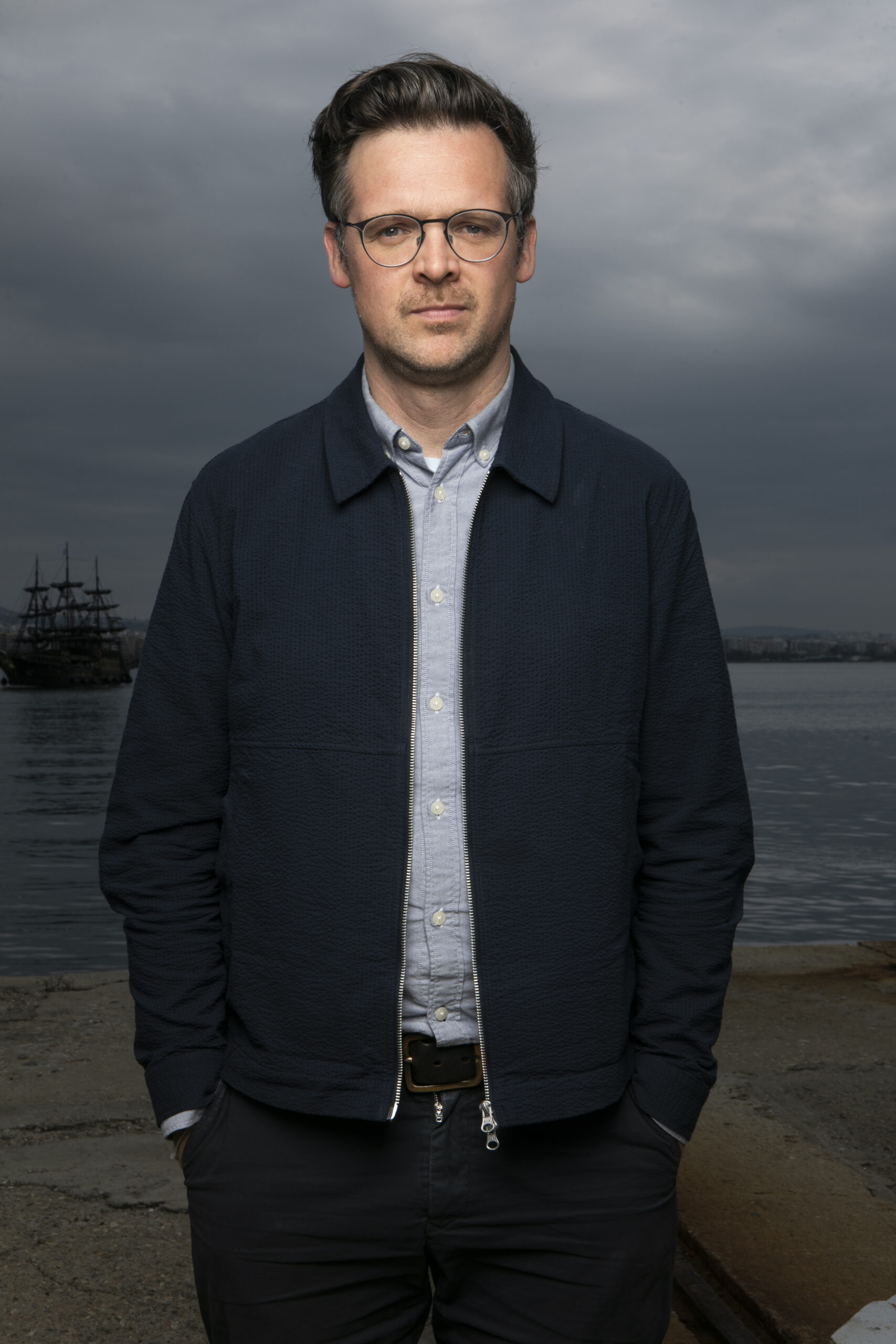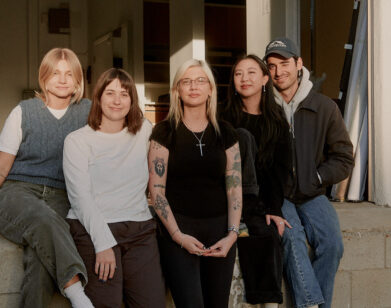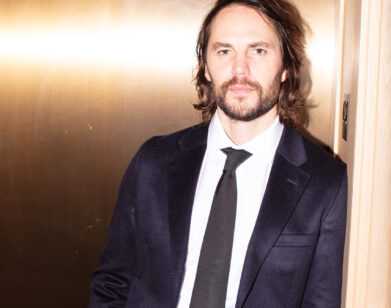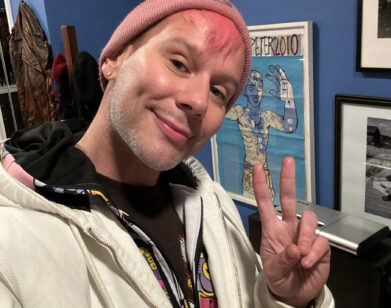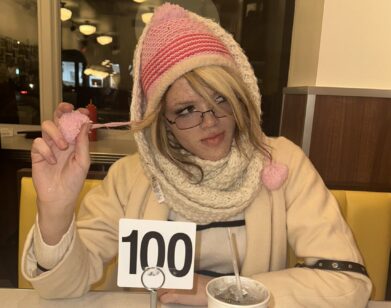DIRECTOR
Filmmaker Matthew Rankin Is Making Cinema Without Borders
Nestled in a Southeastern corner of Europe, where the Balkans give way to Turkey and the Middle East, the Greek port city of Thessaloniki, with its remnants of Byzantine and Roman history, feels like the right kind of place to talk to Matthew Rankin. The director’s latest film, Universal Language, boldly reimagines his native Winnipeg as an Iranian city where Farsi is the dominant language, The Guess Who’s lyrics are recited like Persian poetry, and the glazed donuts in Tim Horton’s are washed down with glasses of loose leaf tea.
The plot, which follows the efforts of two schoolgirls to retrieve a bank note they find frozen in the ice, was inspired as much by family history as by Iranian cinema of the ‘70s and ‘80s, an era when filmmakers like Mohsen Makhmalbaf found ways to circumvent strict state censorship laws by making sociological films that centered children. Universal Language plays to the soothing rhythms of that era while losing none of the humor and surrealism of Rankin’s previous work, which has already drawn comparisons to Guy Maddin, Winnipeg’s poet laureate of the weird.
The director’s arrival in Thessaloniki was just the latest stop on a festival tour that began in Cannes earlier this year and may yet come to a heady climax at next year’s Oscars, where the film has been selected to represent Canada in the International Feature race, a first for a Farsi-language film. We met inside one of the port’s redeveloped shipping warehouses, the Aegean sea lapping calmly outside, to talk about solidarity, creating a third space, and of course, Iranian movies.
———
RORY O’CONNOR: Congratulations on the Oscar nod. Was that a surprise for you?
MATTHEW RANKIN: Yeah, it was very bizarre. But it’s great. We were just in L.A. and went through the United States. Pirouz [Nemati], our collaborator, he was doing the European festivals, and I just now caught up with him.
O’CONNOR: Last year at the Oscars, there were two German films—one representing Germany, the other the UK. You also had Wim Wenders with a Japanese film, Perfect Days. This year, there could be your film for Canada alongside Seed of the Sacred Fig, representing Germany and also in Farsi. This feels fitting to me.
RANKIN: That’s true. There’s a trans-nationalism, all the blurred lines there.
O’CONNOR: I really like the idea of this kind of shared syntax of filmmaking. How did you come to that idea?
RANKIN: It was a very collaborative, collective process. The basic idea is to blend the poetic realism of the great Iranian masters with what I consider Canadian surrealism. Putting these two cinematic languages together in an intimate dialogue to create a third space. Cinema can do that. It involves so much cheating: cities playing other cities, spaces playing other spaces, people playing other people. Even day sometimes plays night. It’s something cinema can say. The artifices lend themselves to that expressive design. Politics can’t do it. Instagram can’t do it. Structured ideology can’t do it. But cinema has the power to do that. We all really believed in this as collaborators. It was an expression of our idealistic longing. We live in a binary, rigid age, so we were working from a position of no borders and absolute fluidity.
O’CONNOR: It’s such a beautiful, delicate approach. At no point did I feel there was any appropriation going on. Was that something you were wary of beforehand?
RANKIN: There is value to solitude. I live in Quebec, one of the great cinematic cultures of the world, I think. Part of the reason is Quebec has insisted on its solitude: “we need our space to do our thing, and you can do your thing over there. But in this zone, we’re just going to do our thing.” That’s a beautiful thing to have spaces like that.
But pushed to its absolute limit, like in the pandemic, our solitude became almost pathological. We became so alone and emerged in a world infinitely more binary than before, largely because we spent so much time alone. Building spaces of togetherness is really important. That’s what this is. I don’t think it undermines spaces of solitude. Both can coexist. But this really is a hybrid piece. We don’t call it an Iranian film or a Canadian film. It’s in a third space. The story comes from my own life, family, and memories. Every scene is connected to something I’ve personally lived. But it’s fed through this prism. Even the degree to which it’s autobiographical becomes abstract. It’s a version of me, but it’s entering a third zone. It was made by a community of people unified by the idea that we were learning how to see by making this movie. Pirouz had never been to Winnipeg before we started. I had spent time in Iran and been learning Farsi but we were all learning about each other and building this together. They’re so intimately interconnected that you can’t separate them. The movie doesn’t fit into how we typically try to understand image-making. We’re at a place in film history where we can reinvent those structures. There are new ways of thinking.
O’CONNOR: “We are all connected, Agah.” This is the line I think of.
RANKIN: That’s right. But my feeling about the world now is that it’s very rigid and lonely. Loneliness can become pathological. It breeds contempt, suspicion, and segregation. We know that isn’t good. Building spaces of togetherness in a non-didactic, poetic way, I think there’s a catharsis to that. That’s what people are responding to.
O’CONNOR: Without getting too much into it, do you think people are resonating with the solidarity message in part because of how volatile the Middle East is at the moment?
RANKIN: I don’t doubt that’s true. There’s more every day to separate and other ourselves. It’s hard on the spirit. We know we’re capable of something better. We have that power. A very gentle film that defies the oppositional modes we’ve been led to understand how the world works—I think people feel a certain relief.
O’CONNOR: There’s so many nice touches in the film. The Tim Hortons as a Tea Shop is great. I love The Guess Who song being recited as a poem. Did you have other ideas that didn’t make it in?
RANKIN: We shot a very funny scene on an ostrich farm. Ostriches are so interesting. The word for ostrich in Farsi translates as “camel chicken.” There’s a lot of turkeys in the movie, but we had this parallel subplot with ostriches. It was funny, but didn’t end up fitting. I’d like to release it sometime.
O’CONNOR: I really loved the diorama-type compositions as well. It made me think of Roy Andersson, the Swedish guy, especially the office scene that bounces from side to side. Were you drawing inspiration from other places?
RANKIN: A little bit. There’s a lot of parents. This movie is sort of the child of a cinematic orgy. All the Iranian masters of course, but I think there’s a lot of Jacques Tati. There would be no Roy Andersson or Ulrich Seidl without Tati.
O’CONNOR: As far as Iranian filmmakers, is there one in particular that is closest to your heart?
RANKIN: I would say Sohrab Shahid-Saless, because he’s really underappreciated. He made two films in the ’70s called Still Life and A Simple Event. They’re masterworks and a big influence on [Abbas] Kiarostami. Then he left for Germany and made very good films there, too. Of course Kiarostami, Mahmoud Bab, Forugh Farrokhzad. I think there’s some Chantal Akerman in the film, like News from Home. And some Marx Brothers.
O’CONNOR: Akerman in your character’s journey from Montreal, maybe. Not an article goes by about your work without referencing Guy Maddin. Is there a connection there outside of you both being from Winnipeg and making weird films?
RANKIN: I learned how to make films from watching Guy and his methods. He’s certainly a cinematic parent for me. Being from Winnipeg, there’s a certain humor that you see in Guy’s films and a lot of films that emerge from there. More than Guy, I would say John Paizs is an influence in this movie as a Winnipeg filmmaker. The sense of the absurd and surreal humor, I think of that as a very Winnipeg thing. Richard Condie made a great animated film called The Big Snit. That one is also a masterpiece. All of those were the community in which I developed a cinematic consciousness. Winnipeggers are just like that, always walking the fine line between the earnest and the ironic.
O’CONNOR: The film also imagines Winnipeg seceding. What’s the history there?
RANKIN: No, it’s Manitoba. In the early days of the Canadian Confederation, all of Western Canada was technically owned by the Hudson Bay Company. Canada bought it and decided they were going to run it, but there were actual people who lived there, the indigenous Métis nation. They said, “We have opinions about this. You can’t just come here and take over. You have to deal with us.” Their leader, Louis Riel, negotiated the Manitoba Act, which made Manitoba a province. These are pseudo-autonomous states within Canada. Riel led this rebellion against the Canadian government, against the Queen. Eventually, he was tried for treason and hanged.
O’CONNOR: But he’s considered a folk hero.
RANKIN: He’s broadly considered the founder of Manitoba. The Métis people emerged out of the encounter between indigenous and settler. The new nation emerged out of their collaboration and common community. Riel’s Manitoba Act was the idea that people between whom you might imagine great distance can be brought into proximity and create this together. You have to do it as a community. The idea of Métisage, the idea of mixing, is in many ways the founding idea of Manitoba as a political community. That is very relevant to our movie.
O’CONNOR: How did you make the jump from that secession to Winnipeg then being an Iranian country, so to speak?
RANKIN: That emerged organically out of a story my grandmother told me. When she was a child, she and her brother found a $2 bill frozen in the ice on the sidewalk in Winnipeg. They went on a city-wide odyssey to get it out, defrauded by a hobo. Later, when I discovered these Iranian films produced by the Kanoon Institute, they reminded me of this story. They’re all about children facing adult dilemmas, morality, discovering personal responsibility and our duty to others. But they’re very poetic, non-didactic, humanist films.
O’CONNOR: Always with children. Or often with children.
RANKIN: There was something about that echo between my then-octogenarian grandma’s story and these Iranian films that I found very touching and beautiful. The idea for the movie emerged out of that – to tell my grandmother’s story through the language of these Kanoon-produced films, which have a very specific cinematic language above and beyond Farsi. As I started working with Pirouz, we became excited about actually making it in Farsi and creating this transnational universe. It’s a way to look at the world in a way we haven’t before.

